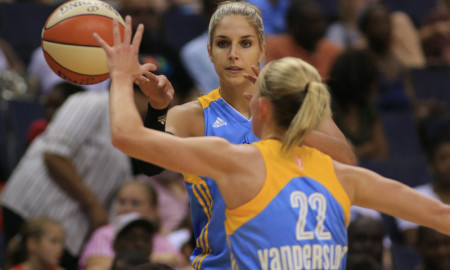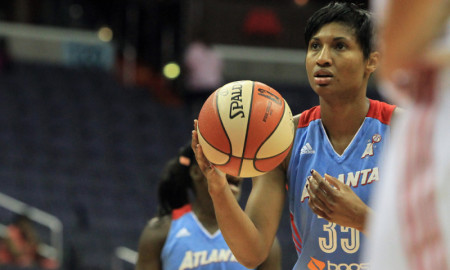2015 Regular Season Record: 20-14 (3rd in Eastern Conference)
Postseason: Defeated Chicago Sky 2-1 in Eastern Conference Semifinals; Defeated New York Liberty 2-1 in Eastern Conference Finals; Lost to Minnesota Lynx 3-2 in WNBA Finals
Following the retirement of longtime head coach Lin Dunn, the Indiana Fever expected to remain competitive in 2015. Enter Stephanie White, who had been an assistant under Dunn in previous seasons. Though she had long since been groomed for the job, White set out to change the Fever’s identity, implementing a new-look offense that would push the pace and play more to the strengths of their current roster.
To say White’s system was successful would be an understatement. In her first year as Indiana head coach, the Fever made it all the way to the WNBA Finals, pushing the eventual champion Minnesota Lynx to the maximum of five games. Not many had picked Indiana to go so far (some wondered whether they would even make the playoffs), but the Fever’s sudden transformation into an offensive powerhouse caught both the league and fans by surprise. No longer did Indiana have to lean so heavily on aging superstar Tamika Catchings, though, she still led the team in usage and scoring. The 2015 Fever had more offensive balance than any other WNBA team, finishing the season with seven players averaging 8 points per game or more.
To illustrate this, Catchings had the worst season of her career in 2015, scoring a career-low 13.1 points per game with an eFG% of just 41.0. Despite this, the Fever still finished third in the WNBA in both pace and offensive rating, scoring a healthy 102.4 points per 100 possessions. In the past, it would have been impossible for any Fever team to put up such numbers with their star player struggling, but the emergence of wings Marissa Coleman and the newly-acquired Shenise Johnson in White’s uptempo system meant that Catchings didn’t have to run the show on her own anymore. The outside shooting ability of Coleman and Johnson meant that the Fever were able to field one of the most dangerous small-ball lineups in the league (with Catchings at the 4), giving their athletic point guard Briann January more room to operate and White more numbers to call on out of bounds plays.
What made this approach so successful was that the Fever were still able to retain their tough, defensive-oriented approach from the past. Though they weren’t impossible to score against (opponents shot the ball at a 47.5 eFG% against the Fever in 2015), Indiana retained the ability to turn opposing teams over. Their defensive turnover percentage of 17.1% edged out Atlanta for the league’s highest theft rate, and it gave them that many more opportunities to push the basketball and score easy points in transition.
In spite of all this, White’s biggest achievement in 2015 might have been overseeing the improvement of Indiana’s role players. Coleman and Johnson (who placed 2nd to Kelsey Bone in 2015 Most Improved Player voting) will get the majority of the attention, but bench players Layshia Clarendon, Lynetta Kizer, and Maggie Lucas all had career years in White’s first season as Fever head coach. Rookie center Natalie Achonwa also contributed when she wasn’t sidelined by commitments to Team Canada. The Fever went from having one of the league’s worst benches in 2014 to one of its best, giving White the opportunity to manage Catchings’ minutes in a way that kept her healthy heading into the playoffs.
Biggest Need Heading Into 2016: Frontcourt Size and Depth
If there’s one thing the Fever lacked in 2015, it was a center playing at the level of the rest of their team. Erlana Larkins had established herself as one of the toughest interior presences in the WNBA under Dunn, but a lingering leg injury held her out of many games in 2015 and greatly reduced her effectiveness. With Achonwa a question mark for several stretches as well, the Fever simply didn’t have good depth inside. That showed in their rebounding numbers: a mediocre 72.9% defensive rebounding rate which meant teams with more size were able to get plenty of second-shot opportunities against this Fever squad. It was exposed in the Finals against series MVP Sylvia Fowles.
That’s not to say they need to look far for help, though. Achonwa is a terrific fit for this team. She’s an intelligent player who’s great in the pick and roll, and she’s generally better at running the floor than most post players as well. Like Larkins, however, Achonwa’s not going to block many shots, and as a young player her future on the defensive end has yet to be determined.
Regardless, the Fever may benefit from looking at a post player in the first round of the 2016 draft. Then again, 2016 will also be Catchings’ final season, and as irreplaceable as she is, the Fever will need to start planning for life after their superstar soon. Despite this, Indiana should remain plenty competitive next season as long as they remain healthy, and another deep playoff run probably won’t surprise anyone this time around.

